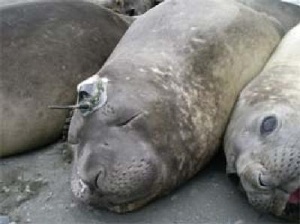Aug 12 2008
Elephant seals are helping scientists overcome a critical blind-spot in their ability to detect change in Southern Ocean circulation and sea ice production and its influence on global climate.
 A tagged seal on South Georgia. Credit: Martin Biuw
A tagged seal on South Georgia. Credit: Martin Biuw
According to a paper published today by a team of French, Australian, US and British scientists in the Proceedings of the National Academy of Sciences, elephant seals fitted with special oceanographic sensors are providing a 30-fold increase in data recorded in parts of the Southern Ocean rarely observed using traditional ocean monitoring techniques.
"They have made it possible for us to observe large areas of the ocean under the sea ice in winter for the first time," says co-author Dr Steve Rintoul from the Antarctic Climate & Ecosystem Cooperative Research Centre (ACE CRC) and CSIRO's Wealth from Oceans National Research Flagship.
"Conventional oceanographic platforms cannot provide observations under the sea ice, particularly on the Antarctic continental shelf where the most important water mass transformations take place. Until now, our ability to represent the high-latitude oceans and sea ice in oceanographic and climate models has suffered as a result."
Co-author, University of Tasmania Professor Mark Hindell says the seal data complements traditional oceanographic sampling from ships, satellites and drifting buoys. "By providing ocean measurements under the sea ice, the seals are helping us to establish the global ocean observing system we need to detect and understand changes in the ocean," he says.
The polar regions play an important role in the earth's climate system and are changing more rapidly than any other part of the world. In the southern hemisphere, the limited observations available suggest that the circumpolar Southern Ocean has warmed more rapidly than the global ocean average and that the dense water formed near Antarctica and exported to lower latitudes has freshened in some locations and warmed in others. Polar changes are important because a number of feedbacks involving ocean currents, sea ice and the carbon cycle have the potential to accelerate the rate of change.
The seals typically covered a distance of 35-65 kilometres a day with a total of 16,500 profiles obtained in 2004-5. Of these, 8,200 were obtained south of 60S, nine times more than have been obtained from floats and research and supply ships. The 4,520 profiles obtained within the sea ice is a 30-fold increase over conventional data. The seals dived repeatedly to a depth of more than 500 metres on average and to a maximum depth of nearly 2000m. The Australian team included scientists from CSIRO, the ACE CRC, the University of Tasmania's School of Zoology and Centre for Marine Science and Charles Darwin University.